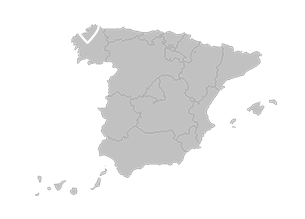.png.transform/rendition-xs/image_image%20(1).png)
Miel de Galicia PGI
Honey produced in hives with movable frames, by decantation or centrifugation, either liquid, crystallized or creamy, or presented in the honeycomb or in sections.
Tasting notes
- Polyfloral: The color varies between amber and dark amber. Flowery aroma of variable intensity and persistence. May be slightly acid and astringent.
- Eucalyptus monofloral: Amber in color, mild flavor and waxy aromas. Sweet, and slightly acid.
- Chestnut monofloral: Dark amber, with reddish touches. A vegetable aroma, slightly acid and bitter, sometimes a little piquant. May be slightly astringent.
- Blackberry monofloral: Dark amber. Aromatic with a persistent flowery smell and fruity flavor. Very sweet.
- Heather monofloral: Dark amber or reddish dark amber. A slightly bitter, persistent flavor and persistent vegetable aromas.
Other notes
Physical and chemical properties:
- Moisture content: maximum 18.5%.
- Diastasic activity: at least 9 on the Schade scale. Low enzyme content, at least 4 on this scale, provided the hydroxymethylfurfural content is no more than 10 mg/ kg.
- Hydroxymethylfurfural: maximum 28 mg/ kg.
- Melisso-palynological characteristics:
In general, the pollen spectrum as a whole should be that of Galician honeys. But the Helianthus annuus-Olea europaea-Cistus ladanifer combination should not exceed 5% of the total pollen spectrum.
Depending on the source of the different types of honey, the pollen spectra should meet the following requirements:
Polyfloral honeys: The pollen should mostly be from Castanea sativa, Eucalyptus sp., Ericaceae, Rubus sp., Rosaceae, Cytisus sp-Ulex sp., Trifolium sp., Lotus sp., Campanula, Centaurea, Quercus sp., Echium sp., Taraxacum sp. and Brassica sp.
Monofloral honeys:
- Eucalyptus: at least 70% must be from eucalyptus(Eucaliptus sp.) pollen.
- Chestnut: at least 70% must be from chestnut (Castanea sp.) pollen.
- Blackberry: at least 45% must be from blackberry (Rubus sp.) pollen.
- Heather: at least 45% must be from heather (Erica sp.) pollen.
Production / Processing method
Hive management shall aim to achieve the best possible quality. Hives may not be chemically treated during honey collection, and the bees may not receive any type of food during this period.
The bees may be removed from the honeycomb by traditional methods, preferably using a bee hole or fanning, but without excessive smoking. Under no circumstances may bee-repellent chemicals be used.
The honey may be extracted by centrifugation or decantation but never by pressing. The whole process must be carried out with maximum care and hygiene in a closed, clean room used only for this purpose and dried one week in advance to bring relative humidity to below 60%, using dehumidifiers or airing.
Under no circumstances may uncapping techniques alter the honey quality. Uncapping knives must be clean, dry and no warmer than 40º C / 104ºF.
After extraction and double filtration, the honey is decanted then any foam removed prior to storage and packaging.
The honey may be homogenized manually or using a slow-turning machine to avoid altering the product characteristics.
Collection and transport of the honey must be carried out hygienically, using food-grade containers authorized by the Regulatory Council and in line with regulations in order to guarantee product quality.
The honey must be packaged on premises registered with the Regulatory Council. Packs for direct consumption generally contain 500 g / 1 lb 2 oz or 1,000 g / 2 lb 3 oz. The jars must be hermetically sealed to prevent the loss of any natural aromas or the incorporation of smells, moisture, etc. which might affect product quality.
Geography / Relief and climate
Galicia's position at the north-western tip of the Iberian Peninsula, between two climates, Atlantic and Continental, gives it a range of climates and flora and, therefore, diversity in honey production.
Regulatory Council
Consejo Regulador de la IGP Miel de Galicia
Pazo de Quián s/n. Sergude
15881 Boqueixón (A Coruña)
Galicia
Tel: (+34) 981 511 913
Fax: (+34) 981 511 913
info@mieldegalicia.org
www.mieldegalicia.org
Sources:
- Spanish Ministry of Agriculture
Hives may not be chemically treated during honey collection, and the bees may not receive any type of food during this period.


- Miel de Galicia 1
- Miel de Galicia 2

Boqueixon -A Coruña (Galicia)
